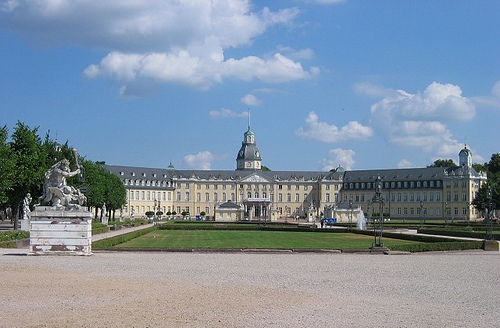

Location: Karlsruhe, Baden-Württemberg Map
Constructed: 1715 by Charles III William of Baden-Durlach
Staatliche Kunsthalle
Hans- Thoma- Strasse
Tel. (0721) 926 3359
Open: 10am- 5pm Tue- Fri
10am- 6pm Sat- Sun
Museum fur Neue Kunst
Lorenzstrasse 9
Tel. (0721) 81 000
Open: 10am- 6pm Wed- Fri
11am- 6pm Sat- Sun
Stadtmuseum im Prinz- Max- Palais
Karlstrasse
10
Tel. (0721) 133 4231
Open: 10am- 6pm Tue, Fri, Sun
10am- 7pm
Thu, 2- 6pm Sat
Karlsruhe Palace is locate in Karlsruhe, Baden-Württemberg region of Germany. Karlsruhe Palace was constructed in 1715 by Charles III William of Baden-Durlach. The palace served as a royal residence until 1918. It was briefly abandoned during the Revolution of 1848 by Leopold, Grand Duke of Baden. The final strike to monarchy came at the conclusion of the World War I when the last monarch Frederick II, Grand Duke of Baden moved out. Karlsruhe Palace was nationalized and turned into Badisches Landesmuseum.
The builder of the original building was Jakob
Friedrich von Batzendorf. The first building was partly made of wood
and had to be completely renovated as early as 1746, with the wooden
structure being replaced by a new stone building. The castle
consisted of two floors and mansards in the attic, with long side
wings adjoining the corps de logis. The seven-story tower (51 m
high) north of the Corps de Logis was originally free and was only
connected to the main building by open wooden galleries.
With
the beginning of Karl Friedrich's reign in 1738, the palace was
rebuilt by the former court junker Friedrich von Kesslau until 1770
according to plans by Balthasar Neumann, which were changed several
times. The most noticeable external features of this conversion were
the larger windows and doors as well as the two pavilions between
the central wing and the side wings of the complex. In 1785, the
castle tower was shortened by Wilhelm Jeremias Müller and received a
domed roof.
In the course of the March Revolution, Grand Duke
Leopold was temporarily expelled from the palace in 1849. The final
end of the use of the castle as a family residence was sealed with
the abdication of the last Baden monarch Friedrich II. In 1918. The
building has served as the Baden State Museum since 1919.
During the Second World War, Karlsruhe Castle burned down in
September 1944 as a result of bombing raids. Between 1955 and 1966
it was rebuilt as a museum. Only the outer facade was faithfully
restored. Modern exhibition areas were created inside. The palace
facade was extensively renovated before Karlsruhe's city birthday in
2015.
The castle tower with its 42 m high viewing platform
can be climbed today as part of a visit to the Badisches
Landesmuseum and offers a panoramic view over Karlsruhe to the Black
Forest and the Palatinate Mountains. The story of the tulip girls,
who enjoyed a somewhat dubious reputation, is presented in the hall
under the viewing platform.
The castle had a
number of representative rooms and others that were intended for the
staff. For the time, the room arrangement was usually combined with
suites. Important rooms were, for example, the marble hall and the
garden hall in the tower wing. Over time, the throne of Baden was
located in different rooms of the castle. The interior was decorated
in the baroque style. Before the war, a number of photographs were
made, mainly by the court photographer Wilhelm Kratt (1869–1949),
which captured the original appearance.
The marble hall got
its name because of the walls that were covered with stucco marble.
The hall was located in the center of the castle and extended over
two floors. There were other representative rooms on both sides of
the hall. The hall was used for official occasions. On the ceiling
was a large painting by the court painter Joseph Melling, showing
the birth of Venus.
From 1719 to 1723 the castle church was
built in the castle by court architect Johann Michael Ludwig Rohrer,
which was completely destroyed in the Second World War.
After
the destruction in World War II, the state administration decided
against the faithful restoration of the interior. The new rooms were
adapted to the museum. Parts of the inventory could be saved and are
kept in the castle, such as the throne of Baden and the crown
jewels. A reconstruction of the state rooms would theoretically be
possible based on the photographic documentation, but has not yet
been tackled.
The palace garden, located on the north side of the palace facing the Hardtwald, was laid out between 1731 and 1746 by Christian Thran in the French baroque style. In the 18th century, Grand Duke Karl Friedrich had parts of the park converted into an English landscape garden. On the occasion of the Federal Horticultural Show in 1967, it was renewed and further developed in the same style. In addition to numerous rare tree species, there are works of art, monuments and fountains from different epochs from the baroque to the modern. A band of 1645 blue majolica tiles has been leading from the castle tower to the majolica factory on the edge of the castle park since 2001. In 1967 the Karlsruhe Palace Garden Railway was put into operation on the occasion of the Federal Horticultural Show. The Karlsruhe Botanical Garden is located on the western edge of the palace garden. The Federal Constitutional Court is located between the botanical garden and the forecourt of the palace.